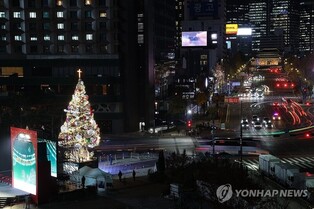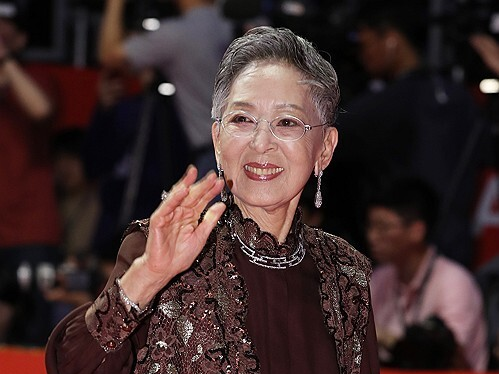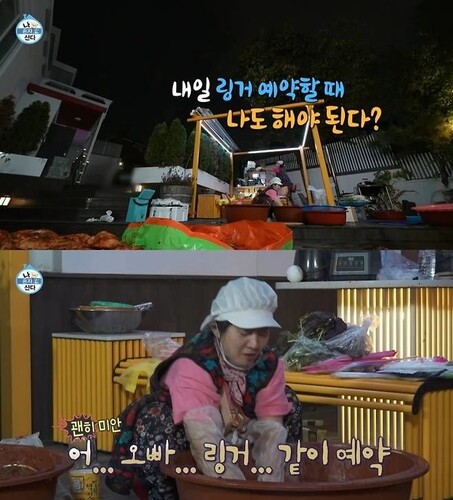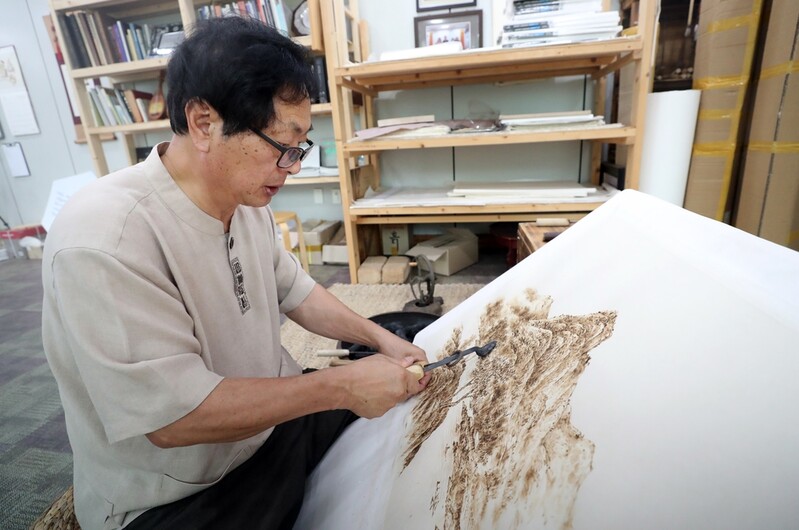 |
| ▲ This photo, shows Kim Young-jo, drawing nakhwa with iron. (Yonhap) |
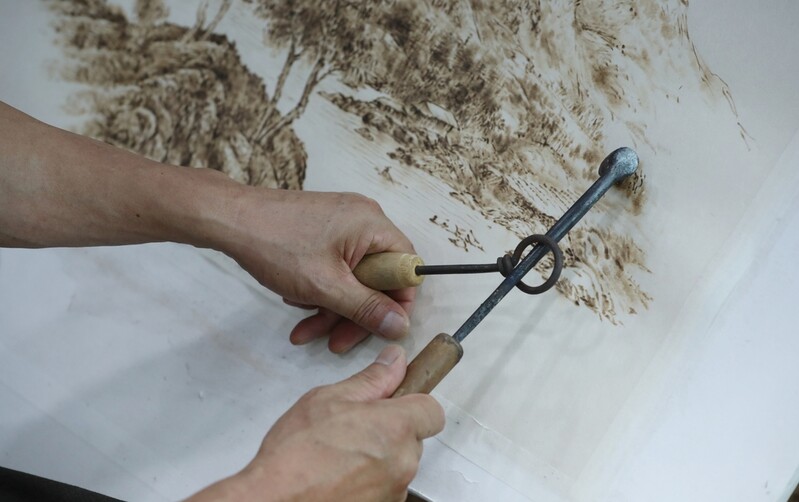 |
| ▲ This photo, shows the iron supporter and iron. (Yonhap) |
 |
| ▲ This photo, shows "see" that Kim Young-jo drew in 2015. (Yonhap) |
 |
| ▲ This photo, shows Kim Young-jo on a interview. (Yonhap) |
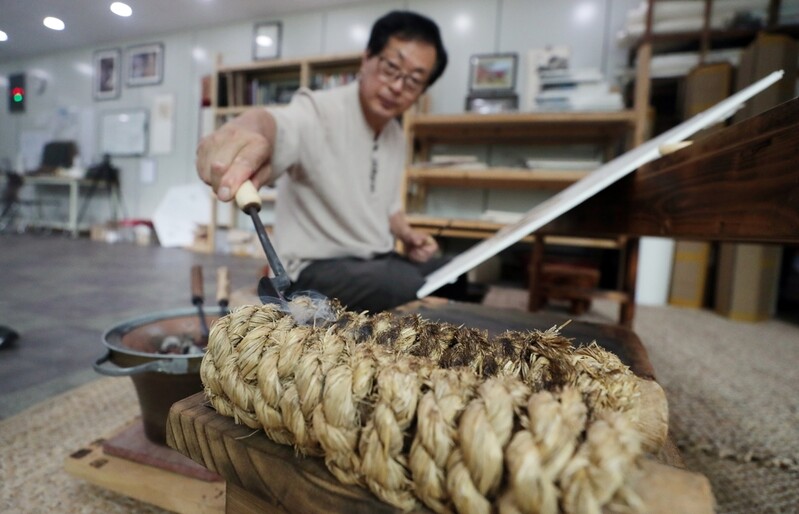 |
| ▲ This photo, shows Kim Young-jo working. (Yonhap) |
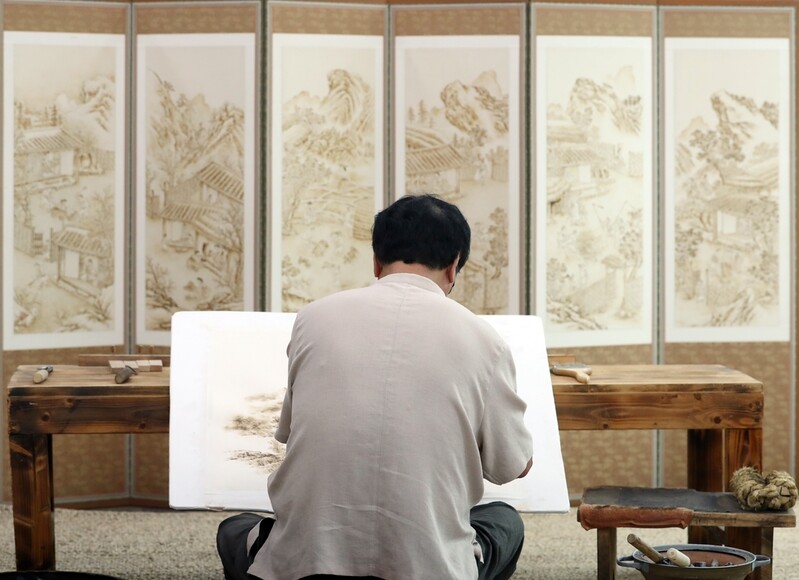 |
| ▲ This photo, shows Kim Young-jo concentrating on his work. (Yonhap) |
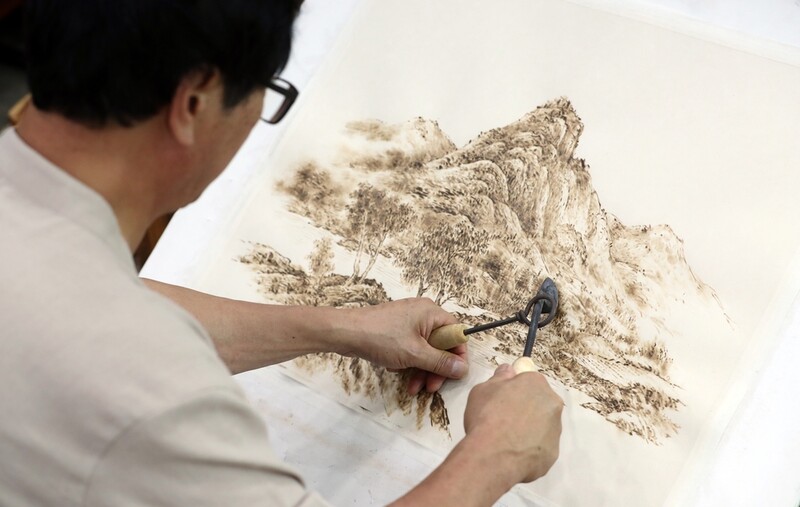 |
| ▲ This photo, shows Kim Young-jo explaining how to use the iron. (Yonhap) |
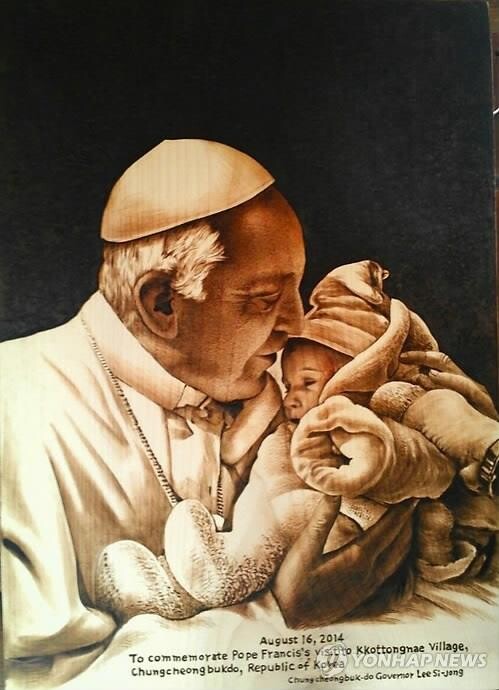 |
| ▲ This photo, provided by the North Chungcheong Province, shows Pope Francis that Kim Younjo drew. (PHOTO NOT FOR SALE) (Yonhap) |
SEOUL, July 29 (Yonhap) -- The hot iron dances on the thin Hanji (Korean paper).
Strange rocks soared up into the sky, and a hazy mist surrounded the moutainside. The branches of the willows by the river began to scatter in the wind as if they have lost their place.
For Kim Young-jo (69), a nakhwajang (traditional Korean pyrography master) and the National Intangible Cultural Heritage No.136, a single iron is a brush itself.
He works on landscape painting. At a glance, it is close to a Western painting centered on realistic depiction.
As one can see from the Chinese characters "geological nak" (烙) and "painting hwa" (畵), Nakhwa is a painting made by heating an iron and running over a surface like hanji, wood, or leather.
While Nakhwa, something that has never left the hand of Kim Young-jo, is a field unfamiliar to the general public, it is a traditional crafting technique with a history of hundreds of years.
In the 19th-century encyclopedia, Oju yeonmun jangjeon sango, which was compiled by the late-Joseon scholar Yi Gyu-gyeong (1788-1863), it mentions Park Chang-gyu (1796- 1861) for being a magnificent nakhwajang painter, and was famous among the Hanyang merchants.
Being fond of drawing from a young age, it was his wish to work in that field.
Since he was 15 years old, when he was in middle school, he began to go to the National Art Exhibition and went there so often, that it was as if he was living there. It was at this time of his life when he began to develop an eye for oriental and western painting.
Finally, in October 2010, he became a holder of intangible cultural assets designated by Chungbuk Province, and in December 2018, he became a holder of national intangible cultural assets and fulfilled his dream.
However, the process was not smooth.
He wanted to receive professional art education at the university, but his family could not afford it.
Kim had to choose between his dream of becoming a famous painter and the reality of having to make a living while drawing signs for theaters.
When he was 19, an opportunity came his way as he saw an article about the "recruitment of Nakhwa students" published in a newspaper in 1972.
During this time, he met his teacher, Jeon Chang-jin, and fell into a path he had never known before, thinking "Landscape paintings are really cool."
Nakhwa is drawn by heating an iron on hot charcoal and then rubbing it with a rope to shake off the ashes, trying to set the appropriate temperature.
However, as they would have to work with the charcoal fire and hot iron even on sweltering days, the working environment isn't the best.
Additionally, it is said that fans cannot be turned on because the ashes attached to the iron could be blown away, leaving a stain on hanji.
Although he studied about flowers, people and many more while sacrificing his sleep, his student life came to an end after two years as his 30-40 classmates left one by one.
Kim gathered the remaining students and practiced for another 7 years. However, his living cost began to stand in the way.
"There was no hope. It was very difficult financially. Back then, Nakhwa was nothing. Neither was it treated as art, nor were nakhwa painters treated as painters. I wondered whether I should let it go."
After giving it a lot of thought, he moved to Songnisan Mountain in the late 1970s and started selling Nakhwa souvenirs made by ironing wooden boards instead of hanji to tourists.
Kim, who was born in Buyeo, South Chungcheong Province, began making a root in Boeun, North Chungcheong Province, where he lived.
As it was a time when tourist souvenirs were not common, Nakhwa gained a sensational popularity, even leaving a record as the most sold souvenir in Songnisan among singular items.
Thanks to this, Kim's life improved and their children were also married.
With his circumstances improving, his passion for painting grew stronger. He practiced copying famous paintings with an iron and a brush, reaching the point where he copied all the paintings in the National Museum of Korea.
"I probably drew thousands of paintings," he said, when asked how much he had studied. "I practiced for 15 hours a day without rest, and it was enough to cut off one steel iron supporter a year."
From then on, another problem began.
While Nakhwa is a painting of great artistic value, he felt a sense of shame that they might not be recognized as they were made rather simply just for souvenirs.
This was around 1995.
With the determination that "you can't make art while maintaining a living," he boldly closed the shops, and in 2000, he began to build the current workshop and exhibition hall, while also beginning to study Nakhwa more professionally.
After 10 years of efforts, on October 1, 2010, he was designated as a Chungcheongbuk-do Intangible Cultural Heritage. His next goal now was to become chosen as a National Intangible Heritage.
There was, however, a long way to go.
This is because there was no Nakhwa in the national intangible cultural heritage category, and there were few experts who understood its artistic value.
After finding old books and documents and persuading them that it was a traditional painting technique, on December 27, 2018, he became the first nakhwajang chosen to be a National Intangible Heritage.
"There was nothing more I wanted to do than show the real Nakhwa who didn't see how valuable it is," he said. "Now, I fulfilled all my wishes."
His work was also delivered to Pope Francis, who visited Eumseong Kkottongnae in August 2014.
Measuring to 43 cm in width, 56 cm in length, and 3 cm in thickness, it was a Nakhwa of the Pope holding a baby and looking at him lovingly on a maple tree. This nakhwa was conveyed to the North Chungcheong province from Kim, and was then handed to the pope.
Currently, his daughter is learning the skills from him.
(This article is translated from Korean to English by Haemin Kim.)
(END)
(C) Yonhap News Agency. All Rights Reserved



















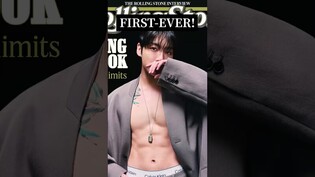
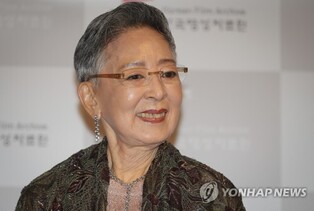
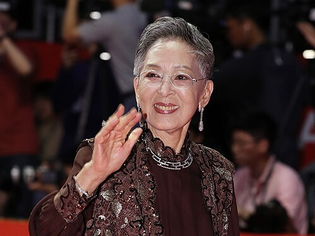
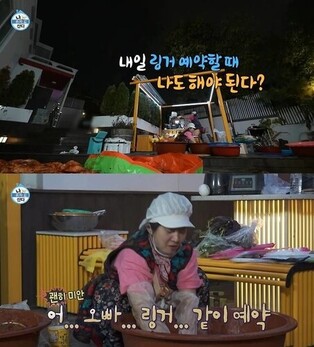
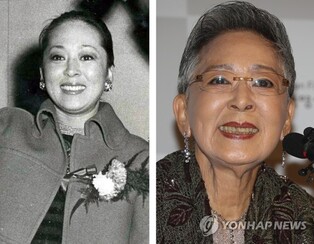
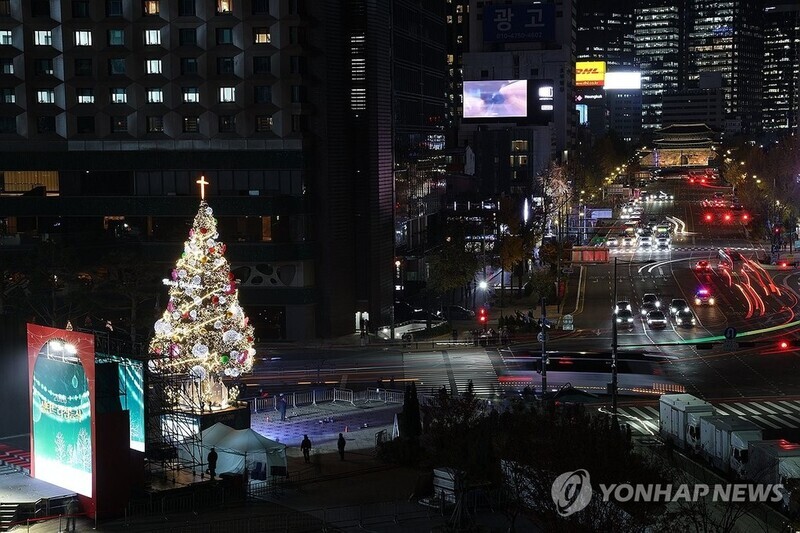

![[가요소식] 10대 싱어송라이터 민서, 데뷔 싱글](/news/data/20251211/yna1065624915952705_742_h2.jpg)
